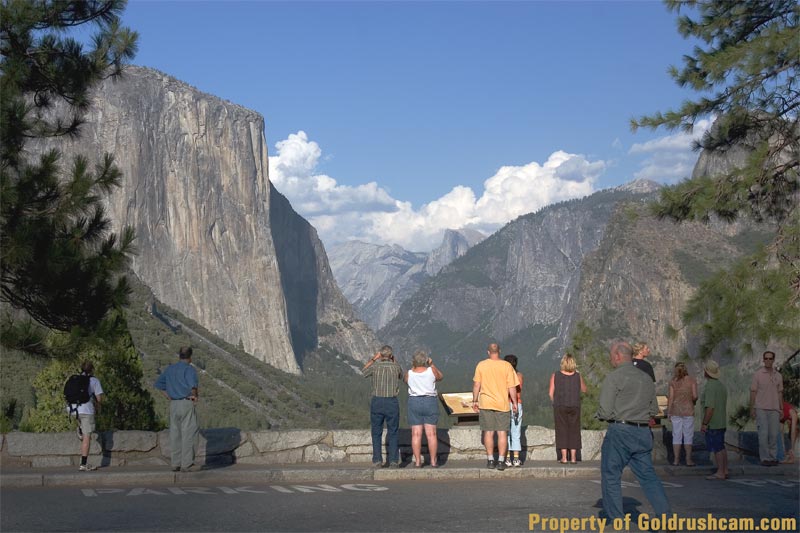
Yosemite National Park
Sierra Sun Times file photo
October 15, 2025 - On Tuesday, the Coalition to Protect America’s National Parks released the following:
October 9, 2025
RE: Docket No. NPS-2025-0037, request for information on improving visitor services
On behalf of the National Parks Conservation Association and the Coalition to Protect America’s National Parks, Re: Docket No. MPS-2025-0037, we are pleased to offer comments on the National Park Service (NPS)’s efforts to improve visitor services.
Since 1919, the National Parks Conservation Association (NPCA) has been the leading voice of the American people in protecting and enhancing our National Park System. NPCA and our more than 1.9 million members and supporters nationwide advocate for America’s national parks and work to protect and preserve the nation’s most iconic and inspirational places for present and future
generations.
The Coalition to Protect America’s National Parks is a nonpartisan, nonprofit organization made up of over 4,600 members, all of whom are current, former, and retired employees or volunteers of the National Park Service. Together, they have accumulated over 50,000 years of experience caring for America’s most valuable natural and cultural resources. More information can be found
at protectnps.org
Since January, NPS has lost more than 25% of its permanent staff. Across the country, parks are cutting ranger programs, closing visitor centers, and falling behind on critical maintenance and research because there just aren’t enough people left to do the job. Sadly, the Park Service was already operating on diminished staffing levels before 2025. Between 2010 and 2023, the Park Service had a 20% decrease in full time staff. During that same thirteen-year period, park visitation grew 16%. And these new cuts to park staffing come as park visitation continues to surge and Americans desire access to nature and our shared history have only grown as we approach the 250th anniversary of America’s independence. In 2024, NPS experienced its highest visitation numbers yet, with approximately 331 million visits by the public to a park. These staggering reductions of staff have left parks across the country scrambling to operate with bare-bones crews while visitors continue to expect a once-in-a-lifetime experience. The park staff who remain are being asked to do more with less, and it’s simply not sustainable.
These staffing shortages result in fewer rangers to protect visitors and resources, less interpretation and education for the public, slower emergency response times, and more strain on already overburdened staff who remain. Ninety national parks reported staffing impacts over the last several months. Nearly 70 parks reduced visitor center hours or visitor services, 22 parks postponed maintenance, and 11 closed or delayed the opening of facilities. It’s clear staffing shortages are directly impacting park operations across the system. Parks like Joshua Tree and Yosemite have been struggling with search and rescue, law enforcement and even basic medical services, while some parks have no maintenance staff at all. Seasonal roads, trails and campgrounds like those at Sequoia & Kings Canyon remain closed due to unaddressed damage. And in remote parks like Cumberland Island, current hiring freezes are limiting the park’s ability to prepare for and respond to urgent needs.
In addition, many park units also depend on private concessions, lease operators and commercial use authorizations to supplement visitor services. With so many vacancies within NPS business permitting, compliance and other admin functions –such as lease agreements and cooperative agreements are all under threat and so are the basic services they provide. Concessionaires and their staff are in many cases the first point of contact for park visitors. They are out in the field mingling with the public, sharing information about programs, hours of operation, transportation services, and so much more. They provide basic amenities such as food, drinks, bathrooms, shade and shelter and augment public educational programming. These concessions invest in historic preservation and basic maintenance that NPS wouldn’t otherwise have the resources for. Lessees provide the public a direct connection to NPS where there are no rangers to be found in the field.
In the short term, we know that the visitor experience will be diminished by these staffing shortages. Visitors from around the world travel to our nation’s 433 national park sites expect to receive one of the world-class experiences that NPS has striven to provide. When visitors are faced with closed visitor centers, trashed bathrooms, and no ranger tours, the visitor experience of these places is in obvious decline. Presumably NPS knows this, as keeping parks open despite staffing shortages is stated agency policy. Secretarial Order 3425 pressures park managers to keep parks open, even when park managers previously would have made a different decision due to insufficient staffing levels. To keep the parks open and comply with this order, park managers have been forced to put NPS resource management staff into front-line visitor service roles.
The role of an NPS park ranger is a varied job; it can bring employees to the top of the tallest mountain in Denali National Park or to running elementary education programs where the Civil War was official ended at Appomattox Court House National Historical Park. Behind the staff that visitors see when they enter a park, there are a legion of staff that support park management and ensure that the resources that visitors come to experience are protected. These staff are the archivists, paleontologists, biologists and social scientists that help uphold the NPS primary legal obligation. These park employees that visitors don’t always see are the backbone of the NPS mission as outlined in the Organic Act of 1916; “to conserve the scenery and the natural and historic objects and the wild life therein and to provide for the enjoyment of the same in such manner and by such means as will leave them unimpaired for the enjoyment of future generations.”
Overemphasizing the needs of the park visitor now could very well undermine the ability of NPS to plan for an unimpaired visitor experience for generations to come. Through chronic underfunding, frontloading of staff to visitor services, and decimation of the natural and cultural resource divisions that protect our nations most valued treasures, NPS is committing to a path that is at odds with their legal obligation and threatens their ability to plan for future generations.
Park staff have attempted to manage the ever-growing number of people who want to visit our nation’s most cherished places. No greater testament to the success of the National Park System can be cited than the ongoing interest visitors pay to these 433 sites. National parks provide unforgettable experiences for millions of visitors, but we need to ensure that the parks’ invaluable resources remain protected.
While year-to-year visitation at a particular park unit may be influenced by seasonal weatherb variability, regional economic outlook, or even local promotional campaigns, NPS ensures consistent visitation data collection year-to-year that allows park managers to analyze larger trends. When examined critically, the experience of many parks over the past decade fit a pattern of continued exponential growth in park visitors. Left unmanaged, the crowds that naturally come with such high visitation might unintentionally hinder the ability of the NPS to uphold its conservation mission to protect and preserve park resources, as well as the enjoyment of those resources, as outlined in the Organic Act.
To be clear, this is not a system-wide issue. Many parks have not seen the same dramatic increase in visitation. While visitation has increased overall across the entire National Park System, there are certain iconic parks experiencing such rapid visitation growth that we should be concerned about natural and cultural resource protection. For instance, Rocky Mountain National Park has been concerned about the growing pressures put on the fragile high alpine terrain by visitors packing onto Trail Ridge Road. The heavy concentration of visitors to these beautiful places has led to people spreading out beyond existing trails and has increased concerns about wildlife disruption, with elk and moose being pushed from natural habitat corridors. Arches and Canyonlands National Parks and surrounding areas have seen multiple, high-profile cases of vandalism of cultural sites, particularly defacement of Indigenous rock imagery. Further, many parks see such large crowds, including during traditionally off-peak times of year, that the overall visitor experience is diminished.
The changing nature of visits and visitors to parks due to the pandemic, increasing types of recreation, climate change, extended shoulder seasons and shrinking off-seasons, and the increase in remote work opportunities mean many parks are likely to continue to see increasing visitation in the coming years. Amidst inadequate budgets for park planning NPS must increase their ability to manage visitor use across the system in order to meet one of the greatest challenges facing NPS in its second century.
At a subset of highly-visited parks, adaptive visitor use management planning and implementation are urgently needed to protect park resources in perpetuity. These systems have been shown to spread visitation throughout the day, rather than limit the number of visitors to the parks. In 2024 with a robust managed access system in place, Yosemite hosted more than 4 million visitors. These systems don’t mean fewer people can enter parks; they just mean a better visitor experience for everyone.
Managed access systems also provide certainty for visitors in places that have them, rather than showing up and potentially finding a closed gate, visitors with reservations know that they will be able to get into the park when they arrive. Especially in times of staffing shortages, these systems can create efficiencies and minimize stress on park staff, while increasing opportunities for resource protection and minimizing staff being used for traffic management. Given all of the benefits of managed access systems, we encourage NPS to maintain superintendents’ abilities to enact them in parks where visitation is exceeding the ability to protect park resources.
The staff are the beating heart of the NPS. Without bolstering the ranks of the park service employees, the visitor experience will be severely degraded. While NPS partners, like concessionaires, can help manage the continued growth of visitors to our national park system, they are no replacement for the professional park rangers that have chosen to serve the American public. Our greatest national treasures deserve their stewards; and the public deserves to experience those treasures fully staffed.
Sincerely,
National Parks Conservation Association
777 6th Street NW, Suite 700
Washington, DC 20001-3723
Coalition to Protect America’s National Parks
2 Massachusetts Ave NE, Unit 77436
Washington, DC 20013
The Coalition to Protect America’s National Parks represents over 3,400 current, former, and retired employees and volunteers of the National Park Service, with over 50,000 collective years of stewardship of America’s most precious natural and cultural resources. Recognized as the Voices of Experience, the Coalition educates, speaks, and acts for the preservation and protection of the National Park System, and mission-related programs of the National Park Service. More information can be found at https://protectnps.org
Source: Coalition to Protect America’s National Parks



